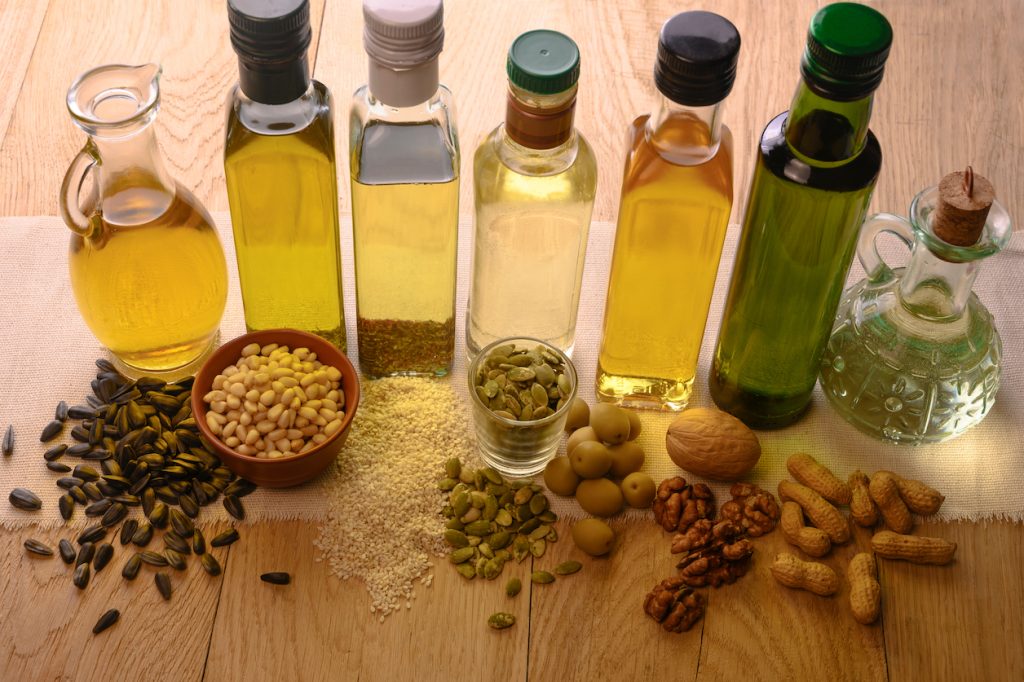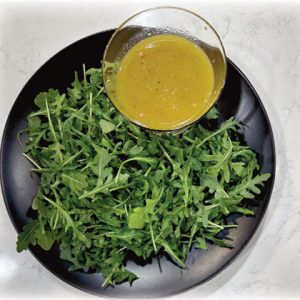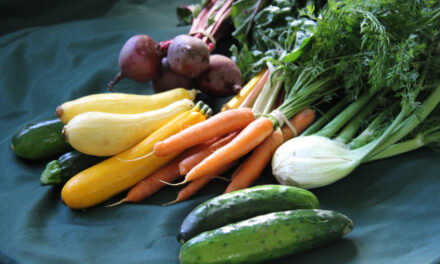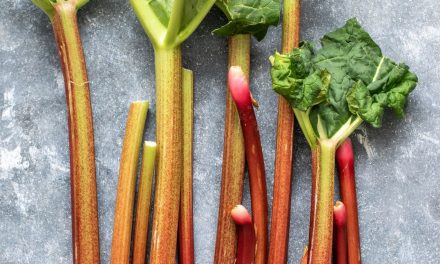
By Linda Davey.
Have you checked out the oil aisle at your local grocery store lately and felt a little overwhelmed with all the choices? From avocado oil to wheat germ oil (there are no x, y, or z cooking oils that I am aware of), which is best for what purpose?
We are probably most familiar with vegetable oil. Over the years, vegetable oil has gotten a bad rap from a health perspective. From saturated and trans fats to the use of crops that have been genetically modified (GMO) to increase yield, determining the healthfulness of vegetable oil is complicated and will depend on the ratio of saturated and unsaturated fats included in the blend, in addition to the original source of the oil and the process by which it is made.
As a category, vegetable oil is any oil made from a vegetable. The vegetable oil on my shelf at home is soybean oil, but it can also be corn, avocado, grapeseed, sunflower, or safflower oil. These oils typically have a high smoke point (don’t break down when cooking at high temperatures), and a neutral flavor. This makes vegetable oil suitable for baking, frying, and sautéing—a good general-purpose oil.
So, if you decide not to use “vegetable oil,” then what? With so many choices, here is an oil primer to help you decide on what oil to use and for which occasion. You can use this information to determine how to substitute for vegetable oil in your cooking, or to determine which oils you prefer in your blend.
For a neutral oil that can be used in place of vegetable oil, try avocado oil. I was introduced to avocado oil as a cooking oil through a cookbook my son received as a gift one Christmas. Avocado oil was the listed oil in almost all the recipes. Previously, I had thought of avocado oil as a skincare oil. Avocado oil is made by pressing the fruit and seed, similar to olive oil. It does retain some of the green color of the fruit, and a bit of the taste, but is still considered neutral in flavor in that it won’t overpower the other ingredients in your dish.

From avocado oil to wheat germ oil (there are no x, y, or z cooking oils that I am aware of), which is best for what purpose?
According to WebMD.com, avocado oil is high in oleic acid, making it heart-healthy, and vitamin E, which helps the body absorb fat-soluble vitamins. It is a monounsaturated fat that is a good source of lutein, a carotenoid (vitamin found in yellow, orange, and red pigmented fruits and vegetables). Avocado oil has been linked to reducing LDL cholesterol and increasing HDL cholesterol. It is thought to lower blood pressure and reduce cardiovascular risk by reversing the inflammatory process. Avocado oil has a high smoke point, it is suitable for sauteing and searing, and its neutral flavor makes it equally suited for salad dressings and baking.
Canola oil, soybean oil, and sunflower oil are often components of vegetable oil, but each stands on its own. Canola oil is made by heating and crushing rapeseed flower seeds. Most of the canola oil sold in the United States is produced in Canada from GMO crops. It has a neutral flavor that makes it suitable for any recipe that calls for oil. Canola oil is also high in oleic acid and has the most ALA (alpha-linolenic acid, an omega-3 polyunsaturated fatty acid), of the common cooking oils. It is a great choice for vegetarian or vegan cooking because of this, but, as with all oils, if you are concerned about pesticides or GMOs, look for oil labeled organic or non-GMO.
Soybean oil is often labeled as vegetable oil or blended with others in vegetable oils. It is high in omega-3s and generally thought of as helpful in preventing bone loss and reducing cholesterol. Sunflower oil, like avocado oil, is high in oleic acid, the same acid shown to be heart-healthy and potentially anti-inflammatory.
Olive oil is made by pressing olives into a paste and then further refining it, resulting in extra virgin, virgin, or light olive oil, with extra virgin being the most flavorful and light being the most neutral. It is considered a healthy oil by many and contains the most oleic acid of any of the oils previously noted.
Coconut oil is another oil frequently associated with skincare, but it is suitable for food preparation. Solid at room temperature, coconut oil can be used as a butter alternative in some baking recipes. For those of you interested in vegan baking, this could be an option. I do recommend testing first with your recipe before baking a cake for your best friend’s birthday, though. Because they are high in saturated fat, it is recommended to limit the consumption of tropical oils like coconut and palm or palm kernel oils.
Peanut oil is a high-smoke-point oil suitable for frying. It is high in monounsaturated fat, and some say that it may help prevent heart disease, lower LDL cholesterol, and reduce fatty buildup in blood vessels. It is also used in the production of some medicines. Peanut oil is considered a major food allergen, so it is best to identify it when using it in your cooking.
Grapeseed oil is a good source of vitamin E and oleic acid. It is most suited for low-temperature cooking and sauces, dressings, and marinades. Made from grape seeds that are a byproduct of winemaking, it is high in polyunsaturated fat and vitamin E.
If you’re looking for a cooking oil that will add a nutty flavor to everything from pie crusts (I add a little bit when making savory pie crusts) and pasta sauces to dressings and marinades, sesame oil may fit the bill. It has a mid-range smoke point that makes it good for sauteing but not stir-frying. Sesame oil is also high in monounsaturated fats and antioxidants. This oil is best stored in the refrigerator.
What about all those other oils? (And there are plenty of them!)
They are worth exploring and may be more easily found in specialty stores or farmers’ markets. While you’re checking them out, look at some of the infused oils. Infused oils are great to use as dipping oils, condiments, or salad dressings. They are simple to make, requiring only some olive oil and fresh or dried herbs.
Basic Oil & Vinegar Vinaigrette

Basic Oil & Vinegar Vinaigrette
Ingredients
- ½ cup grapeseed oil
- 3 tablespoons vinegar of choice balsamic vinegar, red wine vinegar, white wine vinegar
- 1 tablespoon Dijon mustard
- 1 tablespoon maple syrup or honey
- 1 tablespoon finely minced shallot
- ¼ teaspoon Montreal Steak Seasoning® substitute salt and pepper or other seasoning you like
Instructions
- Whisk vinegar, mustard, syrup or honey, shallot, and seasonings in small bowl until well combined. While whisking, drizzle in oil until fully incorporated (emulsified). Transfer to a sealed jar and store in the refrigerator up to 2 weeks. (You may notice that it solidifies a bit in the refrigerator. Let it rest at room temperature for 5 to 10 minutes before serving and stir or shake to recombine.).

Vegan Coconut Oil Brownies
Ingredients
- ½ cup coconut oil refined if you prefer no flavor
- ½ cup dairy-free chocolate chips
- 1 cup granulated sugar
- ½ cup almond milk or other non-dairy milk
- 2 teaspoons vanilla extract
- ¾ cup all-purpose flour
- ½ cup cocoa powder
- ½ teaspoon salt
- ½ cup more chocolate chips optional, for folding in
Instructions
- Preheat oven to 350 degrees and lightly grease an 8” x 8” baking pan.
- In a large microwave-safe bowl or in a double boiler, add coconut oil and ½ cup chocolate chips, being careful to not add too much oil. Cook until melted and smooth (2 minutes in microwave, then 30 second intervals). Whisk in sugar until it dissolves in warm oil/chocolate mixture. Add milk and vanilla and whisk well to combine.
- Add flour, cocoa powder, and salt to a separate bowl and whisk to combine. Add to chocolate mixture and stir, being careful not to over mix. Stir in additional chocolate chips if using.
- Pour into prepared pan and bake 30 minutes, until the top is crinkly and the edges are beginning to pull away from the sides. Let cool 30 minutes before cutting.







